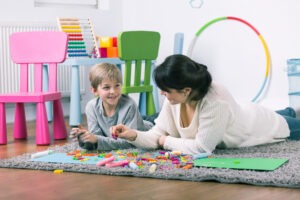What is a Sensory Wall?
Fun, creative, stimulating, easy to make, educational, and entertaining!
A sensory wall is a space on a wall that provides tactile (touch) sensory input to children’s fingers and hands. The wall allows kids to really explore their senses and discover the world around them.
Children of all ages can benefit from this method of exploration. It helps ensure their bodies get the input they need, which can improve their attention and readiness to learn throughout the day. Sensory experiences that occur in a natural environment (like a child’s home) can help children stay focused and organized when they are at school (Dunn, 2007). Another benefit of sensory play? Parents have reported that pleasant sensory activities help calm and “recenter” their children (Dickie, et al, 2009). Not to mention, it encourages your child’s language development.
Now, what is a sensory wall?
You may have heard of a sensory bin; a large container with a filler and a variety of objects. A sensory wall stimulates your child’s senses in a similar way, through a variety of textured objects that are placed on a designated wall.
Let’s Start Creating!
Time to create your child’s sensory wall!
Hang
Find a wall space in your home that your child could reach either while sitting or standing. Hang a large bulletin board or large pieces of cardboard on the wall.
Attach
Buttons Sandpaper Colorful pom poms
Furry fabric Pieces of yarn Artificial grass
Seashells Velcro Koosh balls
…and anything else you find that could be fun for your child to touch and feel!
Glue these items on, in no particular order, and you’re all set.
Themed Walls
Sensory walls are meant to be creative and unstructured, but you can create one of these somewhat “themed” walls and see where your child’s interests take them!
Mermaid Sensory Wall
Locks & latches (great for developing fine motor skills!)
Whiteboard (drawing on it helps develop your wrist extension and proper hand positioning for writing.)
Velcro board (and fill a basket with items that may or may not stick to it!)
Marble run (attach planks of wood or cardboard as ramps and slides.)
Let Learning Begin.
Now that your wall is completed, your child can engage in this fun sensory experience in whatever way they choose!
Kids can explore their new sensory wall on their own, or you can play next to them! By doing this, you can model touching and feeling all of the different textures with a positive attitude, which can help get your child interested and involved.
To boost your child’s language skills, narrate descriptive words out loud as you both interact with the objects on the wall. The hands-on experience will help him or her learn the meaning of words like spatial concepts (“on”, “off”), actions (“stick”, “fall”), and descriptive words (“fuzzy”, “rough”).
Let problem-solving skills work. Resist the parental urge to jump in and help your child, for example, to open a latch or pull off a velcro object that is stuck. This helps your child develop his or her problem-solving skills, work those fine motor muscles, and give an opportunity for your child to practice communicating their needs.
The Next Steps
During activities like this, if you become concerned with your child’s sensory processing skills, fine motor skills (ability to use their hands/fingers), or speech and language development, it may be beneficial to seek resources that can help.
TherapyWorks provides Speech Therapy, Feeding Therapy, Occupational Therapy, and Social Work services via teletherapy. Teletherapy is a convenient, effective model that allows your child’s skills to be evaluated in his or her natural environment. If continued services are recommended, your therapist will guide you through creating more at-home activities like sensory walls to encourage your child’s development and improve areas of concern.
Take advantage of this time at home with your children and enjoy sharing exciting experiences like this one!
If your have concerns about your child’s development, please don’t hesitate to reach out!
References
Dickie VA, Baranek GT, Schultz B, Watson LR, McComish CS. Parent reports of sensory experiences of preschool children with and without autism: a qualitative study. Am J Occup Ther. 2009;63(2):172-181. doi:10.5014/ajot.63.2.172
Dunn, Winnie PhD, OTR, FAOTA Supporting Children to Participate Successfully in Everyday Life by Using Sensory Processing Knowledge, Infants & Young Children: April-June 2007 – Volume 20 – Issue 2 – p 84-101 doi: 10.1097/01.IYC.0000264477.05076.5d



